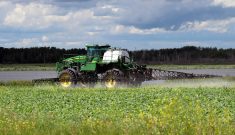Canadian farmers are getting ready for harvest, with grain destined for consumers around the world who are relying on Canada to help address global food security concerns. As part of its commitment to providing safe, high-quality canola, cereals and pulses from Canadian farmers to our international customers, Keep it Clean has developed a number of tools farmers can use to protect the marketability of their crops.
“Market access issues and residue limits can impact Canada’s ability to sell grain,” says Greg Bartley, director of crop protection and crop quality at Pulse Canada. “That is why the Keep it Clean initiative focuses on equipping farmers with resources they can use to make quick, informed decisions in the field.”
These resources include digital tools to help farmers make application decisions and protect the marketability of their crops.
Read Also

Claas brings 1000 Series SP forage harvesters to Canada
In mid-August, Claas unveiled its new line of Jaguar forage harvesters at an event in Visalia, California, deep in the heart of that state’s dairy region.
“Before harvest, one of the most important things we can do to protect the marketability of crops is to follow the pre-harvest interval of each product applied, make sure the crop is at the correct stage and follow the Keep it Clean product advisory to ensure that the product being applied is acceptable to international markets,” says Bartley.
To help with those decisions, Keep it Clean offers as tools the Pre-Harvest Glyphosate Staging Guide, a Spray to Swath Interval Calculator and the annual Product Advisory.
“The Pre-Harvest Glyphosate Staging Guide is a valuable tool that growers and crop advisors can use,” says Krista Zuzak, director of crop protection and production at Cereals Canada. “The guide provides visual examples of various crops at less than 30 per cent grain moisture and steps to assess moisture levels in the field.”
Applying pre-harvest glyphosate too early can result in unacceptable glyphosate residues in the harvested grain and could potentially jeopardize market access.
With the Spray to Swath Interval Calculator, farmers can input a crop type and the product sprayed to instantly find out how many days after application they must wait before cutting the crop. A product to fit a harvest timeline can also be found by putting in the crop and the days until harvest.
“Pre-harvest intervals are part of every crop protection (product) label, but finding them can be difficult,” says Ian Epp, agronomy specialist at Canola Council of Canada. “We developed this tool specifically so farmers, retailers and agronomists would have this information at their fingertips.”
Every spring, Keep it Clean releases its product advisory to raise awareness of the potential market risks associated with certain crop protection products on certain crop types. Use of products listed in the advisory may restrict marketing options due to missing or misaligned maximum residue limits (MRLs) in export markets or market acceptance issues by certain buyers.
“It is important for farmers to be aware of these restrictions and consult with their grain buyers before making product application decisions,” says Bartley. “This helps protect crop marketability and Canada’s reputation as a trusted supplier.”
On Aug. 3, Keep it Clean held a webinar to demonstrate these tools, share tips for keeping crops market ready at harvest and answer questions from participants. A recording of this webinar and all of the tools and tips from Keep it Clean can be found at keepitclean.ca.















